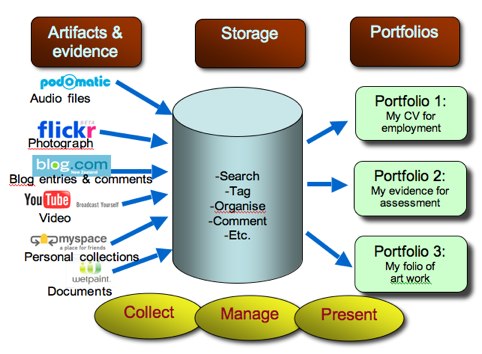Scrum is a lightweight approach to project management based on iterative and incremental practices and which is particularly well suited to e.g rapid software development. It differs from more traditional project management insofar as it is not ‘artefact-driven’ – it does not rely heavily on documents (user requirements, analyses, specifications, design documents, etc etc) Rather it is based on “a flexible, holistic product development strategy where a development team works as a unit to reach a common goal”, challenges assumptions of the “traditional, sequential approach” to product development, and enables teams to self-organize by encouraging physical co-location or close online collaboration of all team members, as well as daily face-to-face communication among all team members and disciplines in the project.
Monthly Archives: July 2014
What are e-portfolios?
 An electronic portfolio (also known as an eportfolio, e-portfolio, digital portfolio, or online portfolio) is a collection of electronic evidence assembled and managed by a user, usually on the Web. Such electronic evidence may include inputted text, electronic files, images, multimedia, blog entries, and hyperlinks. E-portfolios are both demonstrations of the user’s abilities and platforms for self-expression, and, if they are online, they can be maintained dynamically over time. An e-portfolio can be seen as a type of learning record that provides actual evidence of achievement. Learning records are closely related to the Learning Plan, an emerging tool that is being used to manage learning by individuals, teams, communities of interest, and organizations. To the extent that a Personal Learning Environment captures and displays a learning record, it also might be understood to be an electronic portfolio. E-portfolios, like traditional portfolios, can facilitate students’ reflection on their own learning, leading to more awareness of learning strategies and needs. Results of a comparative research, by M. van Wesel and Prop, between paper-based portfolios and electronic portfolios in the same setting, suggest use of an electronic portfolio leads to better learning outcomes. Types There are three main types of e-portfolios, although they may be referred to using different terms:
An electronic portfolio (also known as an eportfolio, e-portfolio, digital portfolio, or online portfolio) is a collection of electronic evidence assembled and managed by a user, usually on the Web. Such electronic evidence may include inputted text, electronic files, images, multimedia, blog entries, and hyperlinks. E-portfolios are both demonstrations of the user’s abilities and platforms for self-expression, and, if they are online, they can be maintained dynamically over time. An e-portfolio can be seen as a type of learning record that provides actual evidence of achievement. Learning records are closely related to the Learning Plan, an emerging tool that is being used to manage learning by individuals, teams, communities of interest, and organizations. To the extent that a Personal Learning Environment captures and displays a learning record, it also might be understood to be an electronic portfolio. E-portfolios, like traditional portfolios, can facilitate students’ reflection on their own learning, leading to more awareness of learning strategies and needs. Results of a comparative research, by M. van Wesel and Prop, between paper-based portfolios and electronic portfolios in the same setting, suggest use of an electronic portfolio leads to better learning outcomes. Types There are three main types of e-portfolios, although they may be referred to using different terms:
- developmental (e.g., working)
- assessment
- showcase
A developmental e-portfolio can show the advancement of skill over a period of time rubrics. The main purpose is to provide an avenue for communication between student and instructor. An assessment portfolio will demonstrate skill and competence in a particular domain or area. A showcase portfolio highlights stellar work in a specific area, it is typically shown to potential employers to gain employment. When it is used for job application it is sometimes called career portfolio. Most e-portfolios are a mix of the three main types to create a hybrid portfolio.
